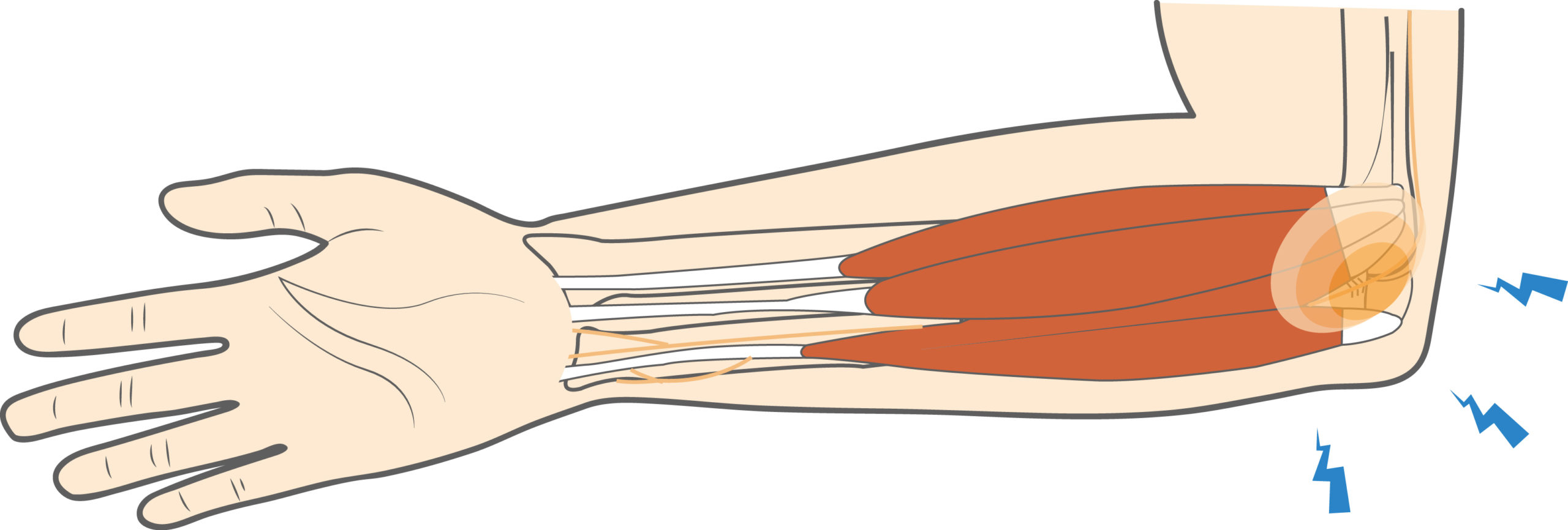Ulnar nerve entrapment is a condition that occurs when the ulnar nerve is compressed, or “trapped,” somewhere along its path through the arm. The ulnar nerve is one of three major nerves in the arm that runs from the neck down to the hand. When the ulnar nerve is compressed in the elbow, this is referred to as cubital tunnel syndrome.
Ulnar Nerve Entrapment (Cubital Tunnel Syndrome) Treatment
Ulnar nerve entrapment is a condition that occurs when the ulnar nerve is compressed, or “trapped,” somewhere along its path through the arm. The ulnar nerve is one of three major nerves in the arm that runs from the neck down to the hand. When the ulnar nerve is compressed in the elbow, this is referred to as cubital tunnel syndrome. This condition is also known for causing funny bone nerve pain.
Overview
Overview

What causes Ulnar Nerve Entrapment (Cubital Tunnel Syndrome)?
The majority of cases of ulnar nerve entrapment occur as a result of repetitive stress to the elbow over a long period of time. This may happen due to:
- Repetitive overuse of the elbow in a bent or flexed position, like in cycling (a common cause of elbow nerve compression)
- Injuries to the elbow, such as fractures and dislocations
Ulnar nerve entrapment can also develop in individuals who suffer from medial epicondylitis (golfer’s elbow) and in some athletes, with ulnar collateral ligament injuries.
Ulnar nerve entrapment is common in these sports:
- Cycling
- Golf
- Baseball
Symptoms
Symptoms generally develop gradually over time, and may include:
- Achiness on the inside of the elbow
- Numbness and/or tingling in the ring and pinky fingers (commonly known as pinky finger numbness)
- Weakness of the hand muscles
When to see a doctor
Your doctor will examine your elbow for signs of tenderness in the area over the ulnar nerve. They will also assess your range of motion and nerve sensation. Your doctor may perform nerve conduction studies to identify where the nerve is compressed and how well it functions, helping them determine the appropriate cubital tunnel syndrome treatment.
In order to make a diagnosis, your doctor may prescribe the following imaging tests:
- X-rays
- MRI
- Electromyogram (EMG)
Non-operative treatment
Initially, your doctor will prescribe conservative cubital tunnel syndrome treatment to relieve your symptoms. These may include:
- Resting the affected arm
- Icing the arm throughout the day
- Nonsteroidal anti-inflammatory medications (NSAIDs) to relieve swelling
- Wearing a brace
Try these exercises to help address your condition:
Below is a PDF of the Exercise Program
Surgical Treatment
If your symptoms do not resolve with conservative treatments or if there is more severe nerve damage as a result of the elbow nerve compression, you may need operative treatment. During surgery to relieve ulnar nerve entrapment, your doctor will remove the cause of compression. This may be a cyst, a bone spur, or scar tissue. Once the tissue is removed, the ulnar nerve is able to regenerate and heal.
Recovery
Recovery from ulnar nerve entrapment with conservative treatments may take up to six weeks. If you require surgery, it may take between four and five months for the nerve to heal completely. During this time, you will be asked to work with a physical therapist or athletic trainer to regain range of motion and strength in the arm.
You can return to play upon instruction from your doctor. Permission to return to full activities is typically granted once you have regained the full range of motion of the elbow with no pain and no weakness in the hand. It may take up to one year for your sensation to fully return.
GET BACK TO WHAT YOU LOVE. FASTER
Frequently Asked Questions
How long does it usually take to diagnose cubital neuropathy?
Diagnosis of cubital neuropathy can take several weeks to months, particularly if symptoms are subtle or intermittent. Delayed diagnosis may occur if symptoms are initially attributed to general overuse or elbow strain.
What happens if funny bone nerve pain is ignored or misdiagnosed?
Ignoring funny bone nerve pain or misdiagnosing it can lead to worsening elbow nerve compression, permanent nerve damage, and loss of hand function. Early medical evaluation is key.
How soon should treatment start after symptoms of ulnar nerve entrapment appear?
Treatment for ulnar nerve entrapment should begin as soon as symptoms like pinky finger numbness or hand weakness appear. Early non-surgical interventions are more effective in preventing long-term damage.
What is the average recovery timeline for surgical vs. non-surgical treatment?
Non-surgical treatment can resolve symptoms within six weeks, while surgical recovery from cubital tunnel syndrome may take 4–5 months. Full return of sensation and function may take up to one year.

